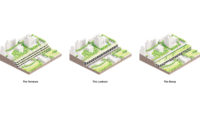New York City is planning to spend $390 million to expand its “Cloudburst” stormwater management program into four sections of the city.
“This is the largest capital investment in Cloudburst design in the U.S. and highlights [Mayor Eric Adams'] commitment to environmental social justice,” Rohit T. Aggarwala, commissioner of the city's Dept. of Environmental Protection, said in a statement.
The four areas set to get improvements are Corona and Kissena Park in Queens, Parkchester in the Bronx and the East New York section of Brooklyn.
DEP is handling contracting for the projects and is currently out to bid for design under four separate contracts. An agency spokesperson says construction should begin in 2025.
The Cloudburst program is focused on addressing flooding from sudden, heavy rain. DEP says the projects would use a mix of gray and green infrastructure to store excess stormwater until heavy rains pass and neighborhood drainage systems have capacity to manage it. The projects would all be designed to mitigate climate change-related extreme weather with up to 2.3 in. of rainfall per hour.
City officials partnered with leaders in Copenhagen to share best practices for the projects. Lykke Leonardsen, Copenhagen’s head of resilient and sustainable city solutions, said in a statement that the projects mark “a major step in flood-proofing” New York City.
Marc Wouters Studios and Grain Collective have completed design for the program’s pilot project at South Jamaica Houses in Queens. The $5-million project is on course to add two grassy areas. And plans call for the rebuilding of a basketball court at a lower elevation to enable the capture and retention of about 300,000 gallons of stormwater.
After 2021’s Hurricane Ida dropped as much as 3 in. of rain in an hour in parts of New York City, overwhelming sewers and causing 13 deaths, city officials prioritized stormwater resilience projects to better protect areas vulnerable to flooding from heavy rain. Other initiatives besides Cloudburst include construction of 3,300 curbside rain gardens, creation of “Bluebelts” with natural drainage corridors like streams and wetlands, deployment of flood sensors and additions of green space and porous pavement.
Adams recently announced the $390 million in capital funds for those projects, as well as others in varying stages of design planned for South Jamaica and St. Albans, in Queens, and East Harlem, in Manhattan. City officials also have picked Brownsville in Brooklyn for a Cloudburst project, but are still pursuing funding for the work.






Post a comment to this article
Report Abusive Comment